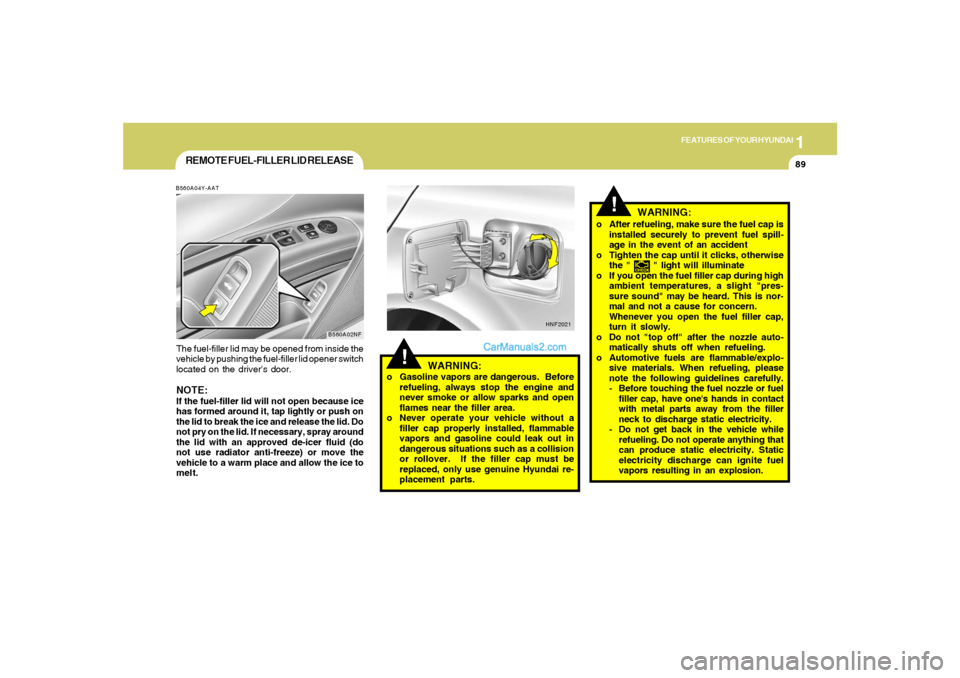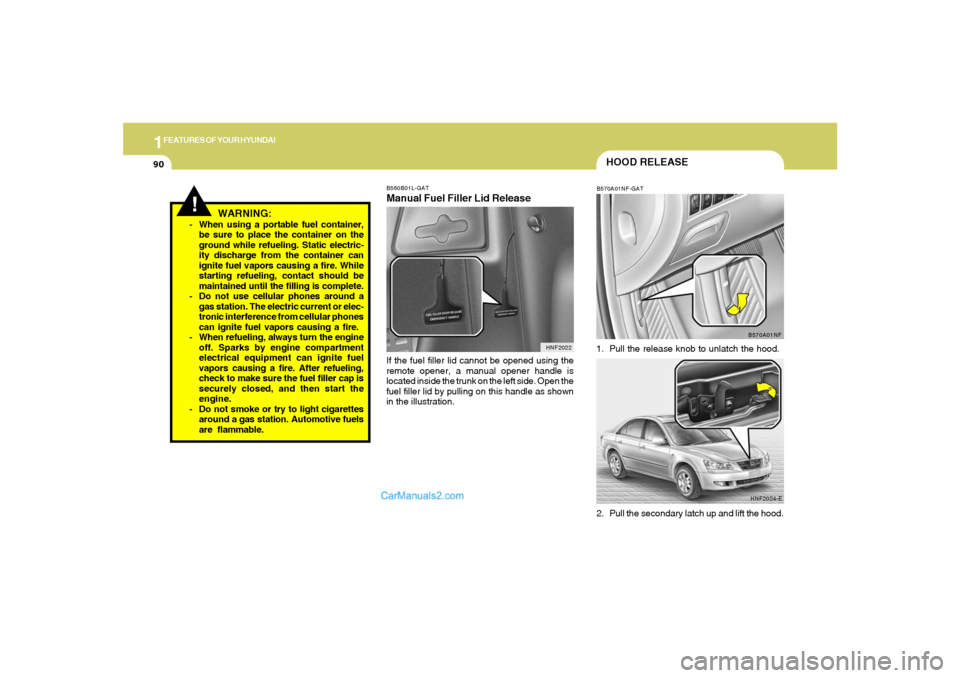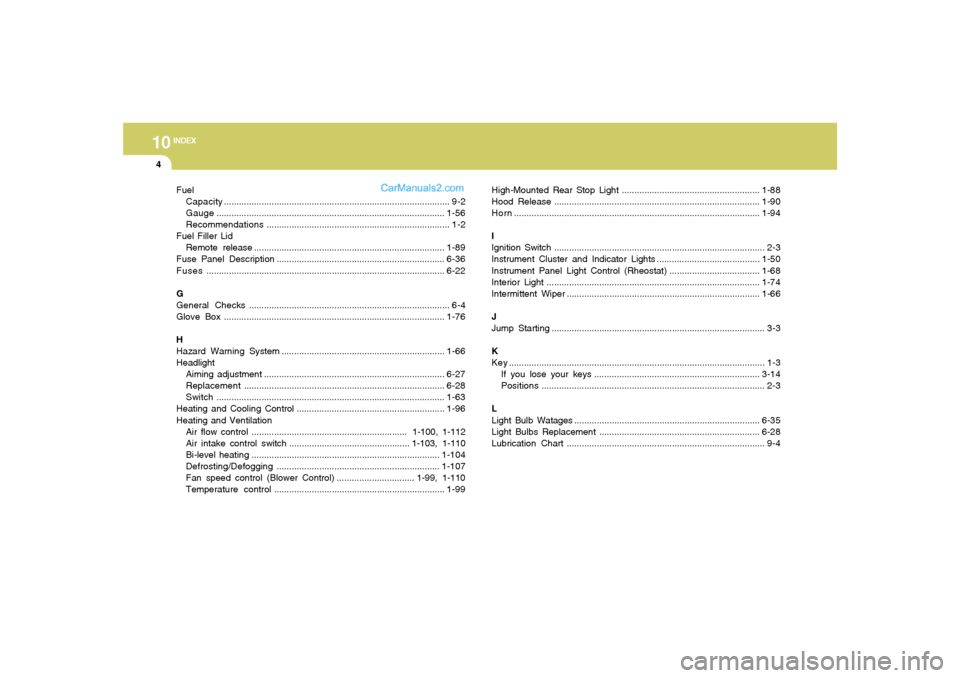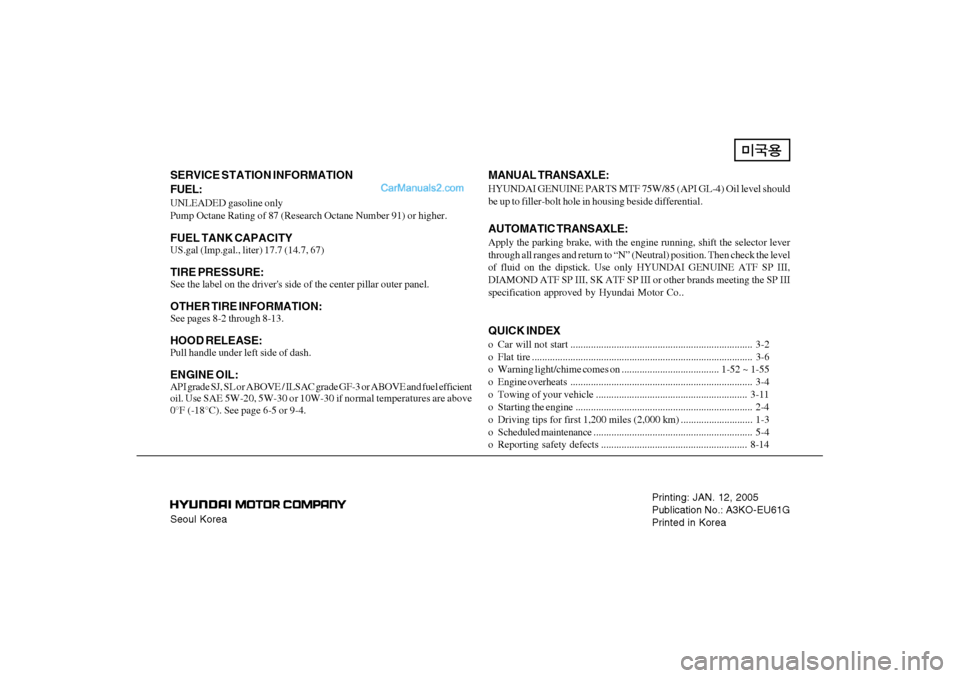fuel cap release Hyundai Sonata 2006 Owner's Manual
[x] Cancel search | Manufacturer: HYUNDAI, Model Year: 2006, Model line: Sonata, Model: Hyundai Sonata 2006Pages: 276, PDF Size: 12.9 MB
Page 103 of 276

1
FEATURES OF YOUR HYUNDAI
89
o After refueling, make sure the fuel cap is
installed securely to prevent fuel spill-
age in the event of an accident
o Tighten the cap until it clicks, otherwise
the "
" light will illuminate
o If you open the fuel filler cap during high
ambient temperatures, a slight "pres-
sure sound" may be heard. This is nor-
mal and not a cause for concern.
Whenever you open the fuel filler cap,
turn it slowly.
o Do not "top off" after the nozzle auto-
matically shuts off when refueling.
o Automotive fuels are flammable/explo-
sive materials. When refueling, please
note the following guidelines carefully.
- Before touching the fuel nozzle or fuel
filler cap, have one's hands in contact
with metal parts away from the filler
neck to discharge static electricity.
- Do not get back in the vehicle while
refueling. Do not operate anything that
can produce static electricity. Static
electricity discharge can ignite fuel
vapors resulting in an explosion.
!
!
WARNING:
o Gasoline vapors are dangerous. Before
refueling, always stop the engine and
never smoke or allow sparks and open
flames near the filler area.
o Never operate your vehicle without a
filler cap properly installed, flammable
vapors and gasoline could leak out in
dangerous situations such as a collision
or rollover. If the filler cap must be
replaced, only use genuine Hyundai re-
placement parts.
HNF2021
REMOTE FUEL-FILLER LID RELEASEB560A04Y-AATThe fuel-filler lid may be opened from inside the
vehicle by pushing the fuel-filler lid opener switch
located on the driver's door.NOTE:If the fuel-filler lid will not open because ice
has formed around it, tap lightly or push on
the lid to break the ice and release the lid. Do
not pry on the lid. If necessary, spray around
the lid with an approved de-icer fluid (do
not use radiator anti-freeze) or move the
vehicle to a warm place and allow the ice to
melt.
B560A02NF
WARNING:
Page 104 of 276

1FEATURES OF YOUR HYUNDAI90
!
WARNING:
- When using a portable fuel container,
be sure to place the container on the
ground while refueling. Static electric-
ity discharge from the container can
ignite fuel vapors causing a fire. While
starting refueling, contact should be
maintained until the filling is complete.
- Do not use cellular phones around a
gas station. The electric current or elec-
tronic interference from cellular phones
can ignite fuel vapors causing a fire.
- When refueling, always turn the engine
off. Sparks by engine compartment
electrical equipment can ignite fuel
vapors causing a fire. After refueling,
check to make sure the fuel filler cap is
securely closed, and then start the
engine.
- Do not smoke or try to light cigarettes
around a gas station. Automotive fuels
are flammable.
B560B01L-GATManual Fuel Filler Lid ReleaseIf the fuel filler lid cannot be opened using the
remote opener, a manual opener handle is
located inside the trunk on the left side. Open the
fuel filler lid by pulling on this handle as shown
in the illustration.
HNF2022
HOOD RELEASEB570A01NF-GAT1. Pull the release knob to unlatch the hood.
2. Pull the secondary latch up and lift the hood.
B570A01NF
HNF2024-E
Page 272 of 276

10
INDEX
4
Fuel
Capacity.......................................................................................... 9-2
Gauge...........................................................................................1-56
Recommendations......................................................................... 1-2
Fuel Filler Lid
Remote release............................................................................1-89
Fuse Panel Description...................................................................6-36
Fuses ...............................................................................................6-22
G
General Checks................................................................................ 6-4
Glove Box........................................................................................1-76
H
Hazard Warning System .................................................................1-66
Headlight
Aiming adjustment........................................................................6-27
Replacement................................................................................6-28
Switch...........................................................................................1-63
Heating and Cooling Control ...........................................................1-96
Heating and Ventilation
Air flow control.............................................................. 1-100, 1-112
Air intake control switch................................................ 1-103, 1-110
Bi-level heating...........................................................................1-104
Defrosting/Defogging.................................................................1-107
Fan speed control (Blower Control) ............................... 1-99, 1-110
Temperature control....................................................................1-99High-Mounted Rear Stop Light .......................................................1-88
Hood Release..................................................................................1-90
Horn..................................................................................................1-94
I
Ignition Switch.................................................................................... 2-3
Instrument Cluster and Indicator Lights .........................................1-50
Instrument Panel Light Control (Rheostat)....................................1-68
Interior Light.....................................................................................1-74
Intermittent Wiper.............................................................................1-66
J
Jump Starting..................................................................................... 3-3
K
Key ...................................................................................................... 1-3
If you lose your keys ..................................................................3-14
Positions......................................................................................... 2-3
L
Light Bulb Watages..........................................................................6-35
Light Bulbs Replacement................................................................
6-28
Lubrication Chart............................................................................... 9-4
Page 276 of 276

Seoul KoreaPrinting: JAN. 12, 2005
Publication No.: A3KO-EU61G
Printed in KoreaSERVICE STATION INFORMATION
FUEL:UNLEADED gasoline only
Pump Octane Rating of 87 (Research Octane Number 91) or higher.FUEL TANK CAPACITYUS.gal (Imp.gal., liter) 17.7 (14.7, 67)TIRE PRESSURE:See the label on the driver's side of the center pillar outer panel.OTHER TIRE INFORMATION:See pages 8-2 through 8-13.HOOD RELEASE:Pull handle under left side of dash.ENGINE OIL:API grade SJ, SL or ABOVE / ILSAC grade GF-3 or ABOVE and fuel efficient
oil. Use SAE 5W-20, 5W-30 or 10W-30 if normal temperatures are above
0°F (-18°C). See page 6-5 or 9-4.
MANUAL TRANSAXLE:HYUNDAI GENUINE PARTS MTF 75W/85 (API GL-4) Oil level should
be up to filler-bolt hole in housing beside differential.AUTOMATIC TRANSAXLE:Apply the parking brake, with the engine running, shift the selector lever
through all ranges and return to “N” (Neutral) position. Then check the level
of fluid on the dipstick. Use only HYUNDAI GENUINE ATF SP III,
DIAMOND ATF SP III, SK ATF SP III or other brands meeting the SP III
specification approved by Hyundai Motor Co..QUICK INDEXo Car will not start ....................................................................... 3-2
o Flat tire ...................................................................................... 3-6
o Warning light/chime comes on...................................... 1-52 ~ 1-55
o Engine overheats....................................................................... 3-4
o Towing of your vehicle ........................................................... 3-11
o Starting the engine ..................................................................... 2-4
o Driving tips for first 1,200 miles (2,000 km) ............................ 1-3
o Scheduled maintenance.............................................................. 5-4
o Reporting safety defects ......................................................... 8-14